Items
Tag
Bisexual
-
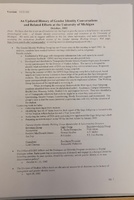 An Updated History of Gender Identity Conversations and Related Efforts at the University of Michigan A timeline, as of October 2002, of conversations, events, and initiatives at the University of Michigan concerning gender identity. Many of the updates since the 2001 file are focused around the Gender Identity Working Group.
An Updated History of Gender Identity Conversations and Related Efforts at the University of Michigan A timeline, as of October 2002, of conversations, events, and initiatives at the University of Michigan concerning gender identity. Many of the updates since the 2001 file are focused around the Gender Identity Working Group. -
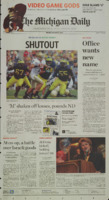 LGBT Affairs Office name change (2 pages), 2007 A digital scan of a page of the Michigan Daily from September 17th, 2007, featuring two halves of an article about the search for a more inclusive name for the University's Office of Lesbian Gay and Bisexual Affairs—the future Spectrum Center. There was growing support for a name that would be more inclusive for transgender and other queer students. Some decried the initiative as taking inclusiveness too far.
LGBT Affairs Office name change (2 pages), 2007 A digital scan of a page of the Michigan Daily from September 17th, 2007, featuring two halves of an article about the search for a more inclusive name for the University's Office of Lesbian Gay and Bisexual Affairs—the future Spectrum Center. There was growing support for a name that would be more inclusive for transgender and other queer students. Some decried the initiative as taking inclusiveness too far. -
 City of Ann Arbor, City of Ypsilanti, and University of Michigan Accomplishments Concerning Sexual Orientation and Gender Identity A timeline, as of June 1999, of Ann Arbor and the University of Michigan's accomplishments concerning gender identity and sexual orientation. The resource is not transgender-specific, but does include transgender-specific accomplishments.
City of Ann Arbor, City of Ypsilanti, and University of Michigan Accomplishments Concerning Sexual Orientation and Gender Identity A timeline, as of June 1999, of Ann Arbor and the University of Michigan's accomplishments concerning gender identity and sexual orientation. The resource is not transgender-specific, but does include transgender-specific accomplishments. -
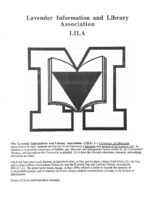 LILA Logo and Summary A sheet of paper stating the name of the organization it represents: Lavender Information and Library Association, or LILA for short. The organization’s logo is present in the middle of the page.
LILA Logo and Summary A sheet of paper stating the name of the organization it represents: Lavender Information and Library Association, or LILA for short. The organization’s logo is present in the middle of the page. -
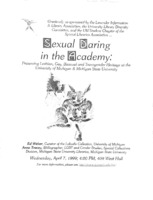 Sexual Daring in the Academy This is a flier that was handed out by the Lavender Information and Library Association to spread the word about a new exhibit coming to the University of Michigan in 1999: “Articfacts and Disclosures: Michigan’s Lesbian, Gay, Bisexual, and Transgender Heritage.” It was the first exhibit of its kind to show off transgender history specific to Michigan.
Sexual Daring in the Academy This is a flier that was handed out by the Lavender Information and Library Association to spread the word about a new exhibit coming to the University of Michigan in 1999: “Articfacts and Disclosures: Michigan’s Lesbian, Gay, Bisexual, and Transgender Heritage.” It was the first exhibit of its kind to show off transgender history specific to Michigan. -
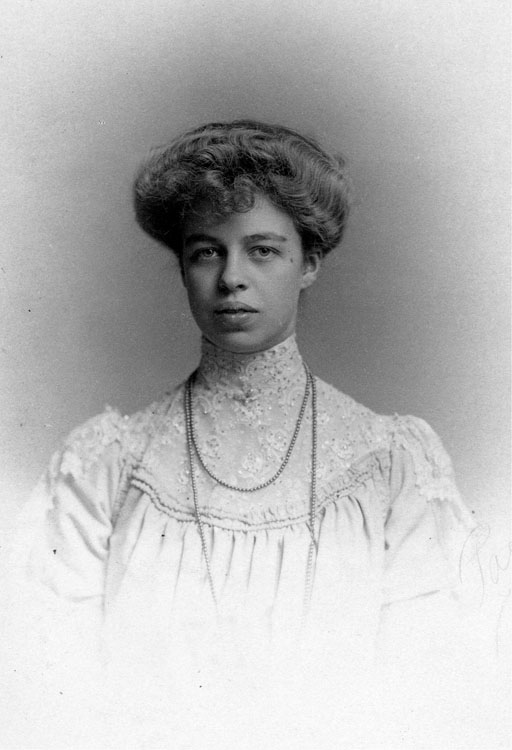 Young Eleanor Roosevelt
Young Eleanor Roosevelt -
 Eleanor Roosevelt and Lorena Hickok with friends
Eleanor Roosevelt and Lorena Hickok with friends -
 Eleanor Roosevelt and Lorena Hickok
Eleanor Roosevelt and Lorena Hickok -
Eleanor Roosevelt to Lorena Hickok, April 19, 1945 This letter was written by Eleanor Roosevelt to Lorena Hickok. The correspondence took place just days after the death of President FDR, Eleanor's husband. In the letter, she grieves for him and speaks about her idea of what life will be like moving forward without him.